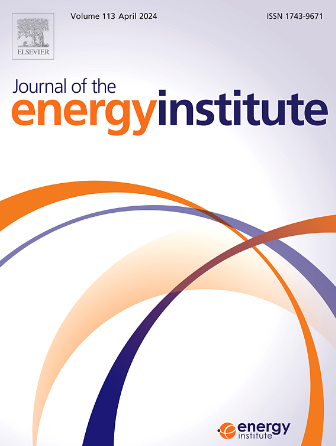Numerical study on flame structure and NOx generation under different Coal/NH3 co-firing strategies in a 1000 MW utility boiler
IF 5.6
2区 工程技术
Q2 ENERGY & FUELS
引用次数: 0
Abstract
Coal/ammonia (NH3) co-firing in power plants is acknowledged as a promising technology for mitigating carbon emissions at source. However, due to the high nitrogen content in NH3, there is a risk of NOx emissions. This study conducts a numerical simulation on coal/NH3 co-combustion in a 1000 MW ultra-supercritical boiler, exploring the impacts of injection strategies on combustion and NO generation characteristics. The strategies investigated include: (1) uniformly injecting NH3 through all burners, (2) non-uniform NH3 injection through selected burners, and (3) NH3 injection via NH3 nozzles. Results reveal that, when NH3 is uniformly injected through all burners, a high co-firing ratio (40 % by calorific value) is needed to establish an elongated flame structure at the burner outlet. Under this condition, NO concentrations at the furnace outlet are reduced to 142.3 ppm, respectively, which are lower than that in pure coal combustion. Non-uniform NH3 injection through selected burners leads to the formation of elongated flame at lower NH3 co-firing ratios, thus diminishing NO production. When introduced through nozzles at the lower section of the primary combustion zone, NH3 tends to move downward to the ash hopper, where intense pyrolysis occurs, limiting the conversion of NH3 to NO and reducing NO emissions.
求助全文
约1分钟内获得全文
求助全文
来源期刊

Journal of The Energy Institute
工程技术-能源与燃料
CiteScore
10.60
自引率
5.30%
发文量
166
审稿时长
16 days
期刊介绍:
The Journal of the Energy Institute provides peer reviewed coverage of original high quality research on energy, engineering and technology.The coverage is broad and the main areas of interest include:
Combustion engineering and associated technologies; process heating; power generation; engines and propulsion; emissions and environmental pollution control; clean coal technologies; carbon abatement technologies
Emissions and environmental pollution control; safety and hazards;
Clean coal technologies; carbon abatement technologies, including carbon capture and storage, CCS;
Petroleum engineering and fuel quality, including storage and transport
Alternative energy sources; biomass utilisation and biomass conversion technologies; energy from waste, incineration and recycling
Energy conversion, energy recovery and energy efficiency; space heating, fuel cells, heat pumps and cooling systems
Energy storage
The journal''s coverage reflects changes in energy technology that result from the transition to more efficient energy production and end use together with reduced carbon emission.
 求助内容:
求助内容: 应助结果提醒方式:
应助结果提醒方式:


